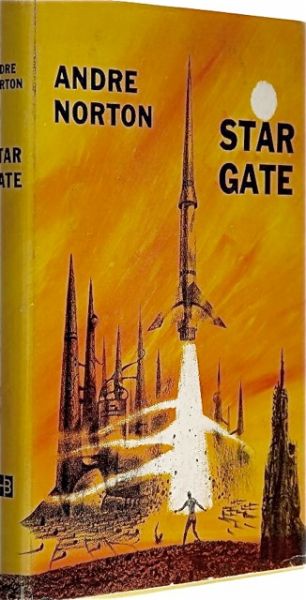Dark Reflection
Star Gate
By Andre Norton

6 Feb, 2015
0 comments
1958’s Star Gate is a standalone novel, but it foreshadows later works by Norton. Here, she tries out new themes: magic and interdimensional gateways. Although this novel’s setting features hi-tech devices like blasters, there is also magic. Starships exist, but the main characters reach their destination via interdimensional gateway.
Years before Kincar s’Rud was born, the Star Lords settled on Gorth, where they attempted to raise Gorth’s twelve-fingered natives from barbarism into the light of civilization (as defined by the Star Lords). The Star Lords eventually concluded that their intervention had inflicted more harm than good. They boarded their great starcraft and left Gorth forever.
Or at least most of the Star Lords left Gorth forever.
The Star Lords declined to take any of the products of Gorthian-Star Lord relationships with them. While such unions did not often produce offspring, there are some people of mixed blood. Kincar is one such mixed-blood. He is the grandson of a native Gorthian ruler, Wurd s’Jastard, lord of Styr Hold, Wurd is dying and will soon be unable to protect Kincar from his other grandson, the full Gorthian Jord, who is determined to inherit the hold. Jord can rely on a widespread Gorthian prejudice against mixed-bloods; any aggression against Kincar will be condoned, even cheered.
Rather than hang around to be assassinated, Kincar flees Styr Hold for a gathering of fellow mixed-bloods and the remaining Star Lords. These Star Lords have formed ties with Gorth and Gorthians. They refused to leave for the stars because they could not bring their Gorthian spouses and children. However, they know that they cannot stay on Gorth, where resentment against the Star Lords still burns hot, so they form an audacious plan. They will use experimental technology to open a gate between worlds of possibility. They hope to find a Gorth that never had intelligent natives, a Gorth the Star Lords can take for their own without guilt.
Where the refugees plan to go and where they actually end up turn out to be rather different places. The first hint that they have not arrived in an empty world free for the claiming is that the group finds itself near an ancient, abandoned Gorthian fortress. Later they learn, to their immense disappointment, that this world also has Star Lords — dark Star Lords whose reason for seeking out Gorth was not to uplift its natives, but to break them to the Star Lords’ will.
The transdimensional refugees make the further alarming discovery that the dark Star Lords are doppelgangers. Every refugee Star Lord has a this-world twin, a dark, twisted twin. Running from their sins, the refugees have met them redoubled. As one Star Lord ruefully admits,
They have poisoned this Gorth, as we to a lesser extent poisoned ours.
It is possible one of the major differences between the two world-lines is the treatment of women therein. The Lady Asgar is strong, capable woman who is one of the leaders of the refugees. These Lords respect women; the Dark Lords keep their women in strict purdah. Just as the dark Star Lords exploit and oppress Gorthian natives, they oppress their own womankind.
(The Star Lords rightly consider themselves better than their doppelgangers but still, the allegedly good Star Lords did abandon many of their Gorthian kin to the mercies of vengeful mobs. Norton draws a nuanced picture here; this is not absolute good against absolute evil.)
While the reader will spot that what Kincar sees as Star Lord magic is actually mundane technology, native Gorthian magic seems to be real. Kincar is the guardian of a sacred stone entrusted to him by his grandfather. This stone, which he wears on a chain around his neck, has real magic powers. The Gorthian gods that Kincar invokes are real, and they eventually prove themselves stronger than the Dark Lords’ evil. Magic and technology can coexist in this world, as they do in Norton’s later Witch World books.
This novel was written at a time when European empires in Africa and Asia were imploding. I suspect that’s part of what shaped the plot of this novel. Oh, and a sense of guilt over the displacement and extermination of the Native Americans that occasionally shapes American SF [1]. One instance of this, I would argue, would be the worldbuilding in Novik’s Temeraire novels, wherein the Incan Empire’s possession of dragons saves them from the predatory Spanish. A far more apropos example is Patricia Wrede’s Frontier Magic series, which is basically Little House on the Prairie + magic, but minus any Osages from whom to steal the land. This is basically another version of the “no natives, no problem” approach the Star Lords were trying with their interdimensional gate.
Although I didn’t care for the Witch World books I read (for reasons I will get into when I get to one), this precursor to them, this merger of science fiction and fantasy, was a pleasant read. One of the reasons this worked for me is that
while Kincar’s magic is important to the resolution, it is not the only strength he brings to the book. For that matter, he is not the only character whose actions shape the plot; Kincar is important, but he is not the only important character. I usually prefer an Avenger-style plot, in which each member brings something of value to the team, to a Doc Savage-style plot, which is all about the heroic Man of Bronze.
This book is available in omnibus form from Baen Books.
1: We white Canadians like to think that we’re benevolent Star Lord types. First Nations folks are not so sure of that.
